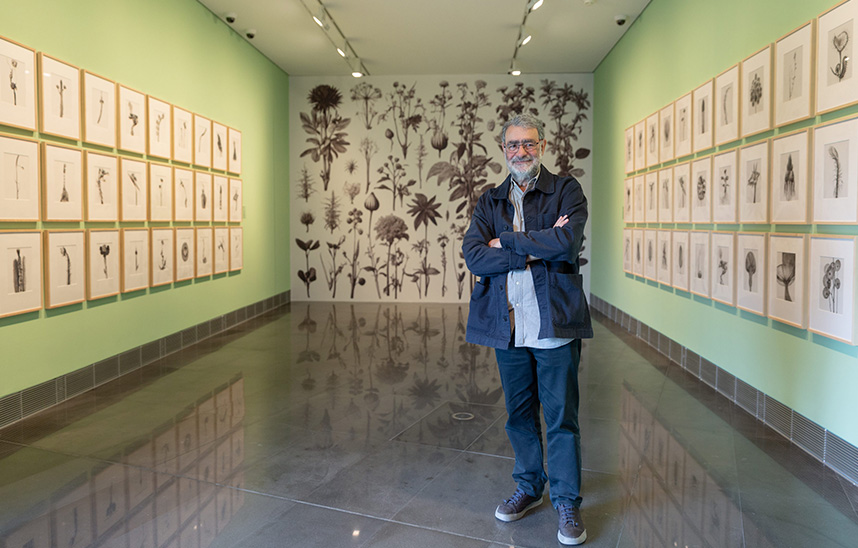The MUN presents "Florilegium", the new creation of photographer Joan Fontcuberta, elaborated with artificial intelligence.

PhotoManuelCastells/
20 | 03 | 2024
At first glance, no one would say that they are not real specimens. Their coloring, shapes and movement do not raise any suspicions. Even their names encourage us to think of specimens studied and catalogued with scientific rigor: Funga mutaphila, Lathirus oleracerus, Linderdina modulata. .. However, we will not be able to find any of these plants outside the walls of the MUN.
The Museo Universidad de Navarra has presented this morning to the media the latest creation of the photographer Joan Fontcuberta, Florilegium. Today at 19h. will take place a masterclass of the artist, with free admission upon withdrawal of invitation. Later, at 20h., will be the opening of the exhibition, which will be at the MUN until next June.
The artist has used Artificial Intelligence to create a fascinating imaginary flora that moves between reality and fiction. The artistic director of the MUN, Valentín Vallhonrat, maintains that in a context in which Artificial Intelligence is gaining more and more strength, Fontcuberta "offers us a method to avoid being entangled and confused in the latest proposal of human intelligence: machines that we can ask to make our dreams come true".
Florilegium is inspired by 18th century engravings and drawings of Latin American flora from the Collection Museo Universidad de Navarra. Since the Enlightenment, the desire to discover new civilizations arose in Europe, which gave rise to expeditions that included scientists and illustrators in their ranks. From their work of observing vegetation, sketchbooks and volumes of expeditions and treasures emerged. These works, Vallhonrat explains, "reflect the efforts to describe and classify botanical species, including the new additions to the plant kingdom discovered in the 18th century."
Fontcuberta uses these works to generate his own species, which also bear names of his own invention, such as Levenfelda Augusta, in homage to the artistic director of the MUN, Rafael Levenfeld, who passed away last November. With this, the artist dialogues with the exhibition A Promised Land. From the Age of Enlightenment to the Birth of Photography, which can be visited at Museo Universidad de Navarra until next August.
"The algorithm can generate non-existent "real" flowers (for example, orchids or tulips)," but also, says Fontcuberta, it can "invent perfectly convincing floral morphologies that do not exist in nature. And he goes one step further: "These morphologies, moreover, to make things even more interesting, can be represented in the visual style we prefer, like that of Walter Hood Fitch when he drew the orchids that James Bateman collected in Mexico and Guatemala, or like that of Karl Blossfeldt or the wildlife photo of National Geographic, because the styles are also subject to discernible styles that can be learned by algorithms. With one click I can turn Fitch's paintings into photographs of my own style".
Joan Fontcuberta (Barcelona, 1955) returns to the MUN after exhibiting Camouflages in 2016. He has carried out numerous projects with the plant world as the protagonist, such as the Herbarium series (1982-85). Four decades later, he remakes this series and proposes new imaginary species. While in the first work he parodied the photographs of botanical specimens taken by the German Karl Blossfeldt, now in Florilegium he replaces the collage of objects and conventional photography he used then with new algorithmic visualization tools, making use of Artificial Intelligence (AI) mechanisms.
Fontcuberta is one of the most relevant photographers in Europe today. He is the only Spanish artist to be awarded the Hasselblad Foundation Prize, one of the most prestigious photography prizes. He has also been distinguished as Chevalier de l'Ordre des Arts et des Lettres, by the French Ministry of Culture, with the National Photography Award and the National Essay Award. In addition to his artistic work, he has worked as a teacher, critic, historian and exhibition curator. In addition, in 1980 he co-founded the magazine Photovision, of which he was editor-in-chief for two decades.
His work deals with the conflicts between nature, technology, photography and truth. He has been the subject of solo exhibitions at MoMA in New York, the Musée Cantini in Marseille, the Art Institute of Chicago, the MNAC in Barcelona, the Palazzo delle Esposizioni in Rome, and the Aperture Foundation in New York, among many others. His works can be found in collections such as the Metropolitan Museum of Art (New York), San Francisco MoMA, National Gallery of Art (Ottawa), Musée d'Art Contemporain- Centre Georges Pompidou (Paris), Maison Européenne de la Photographie (Paris), Stedelijk Museum (Amsterdam), MACBA (Barcelona) and the Museo Universidad de Navarra.